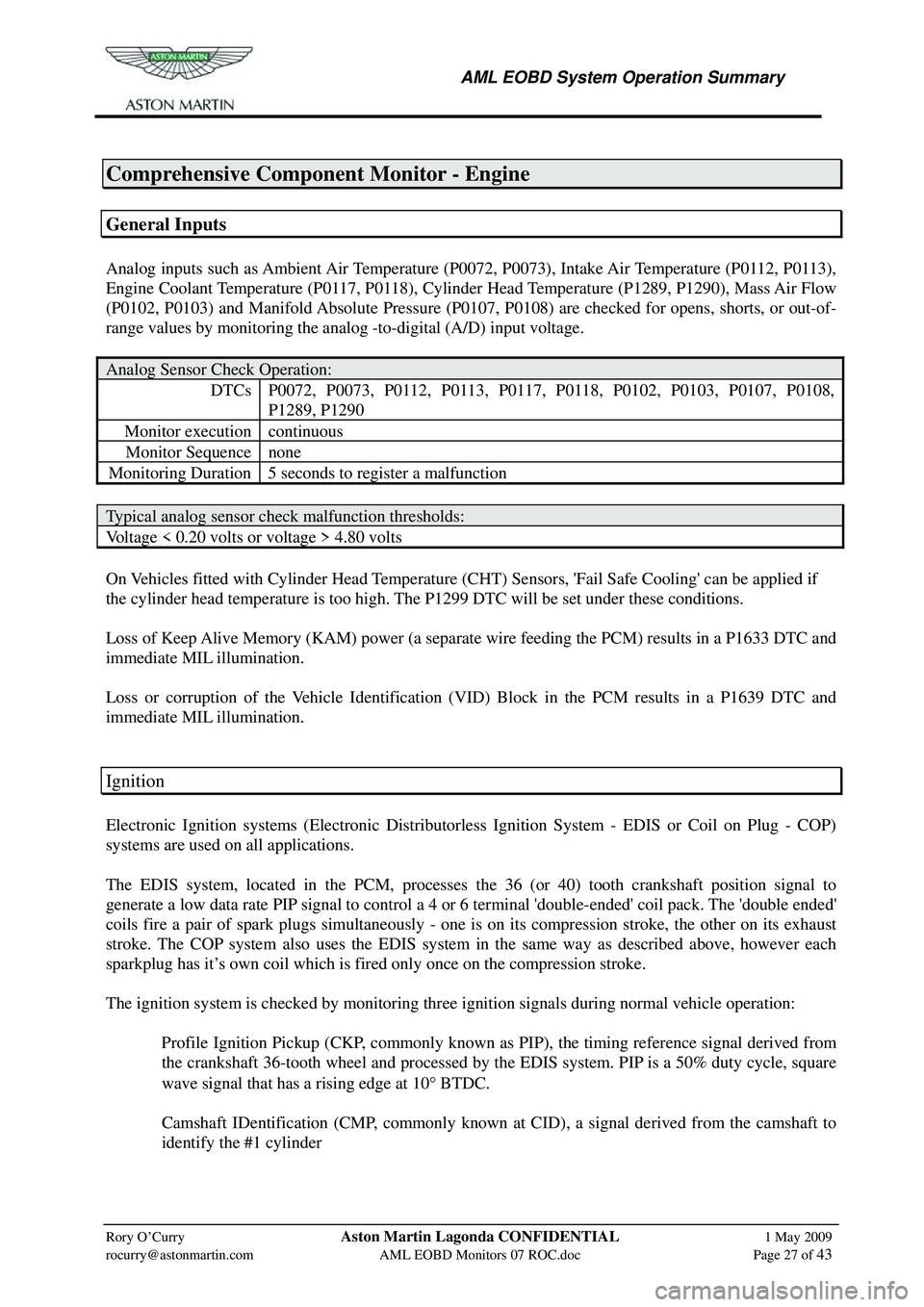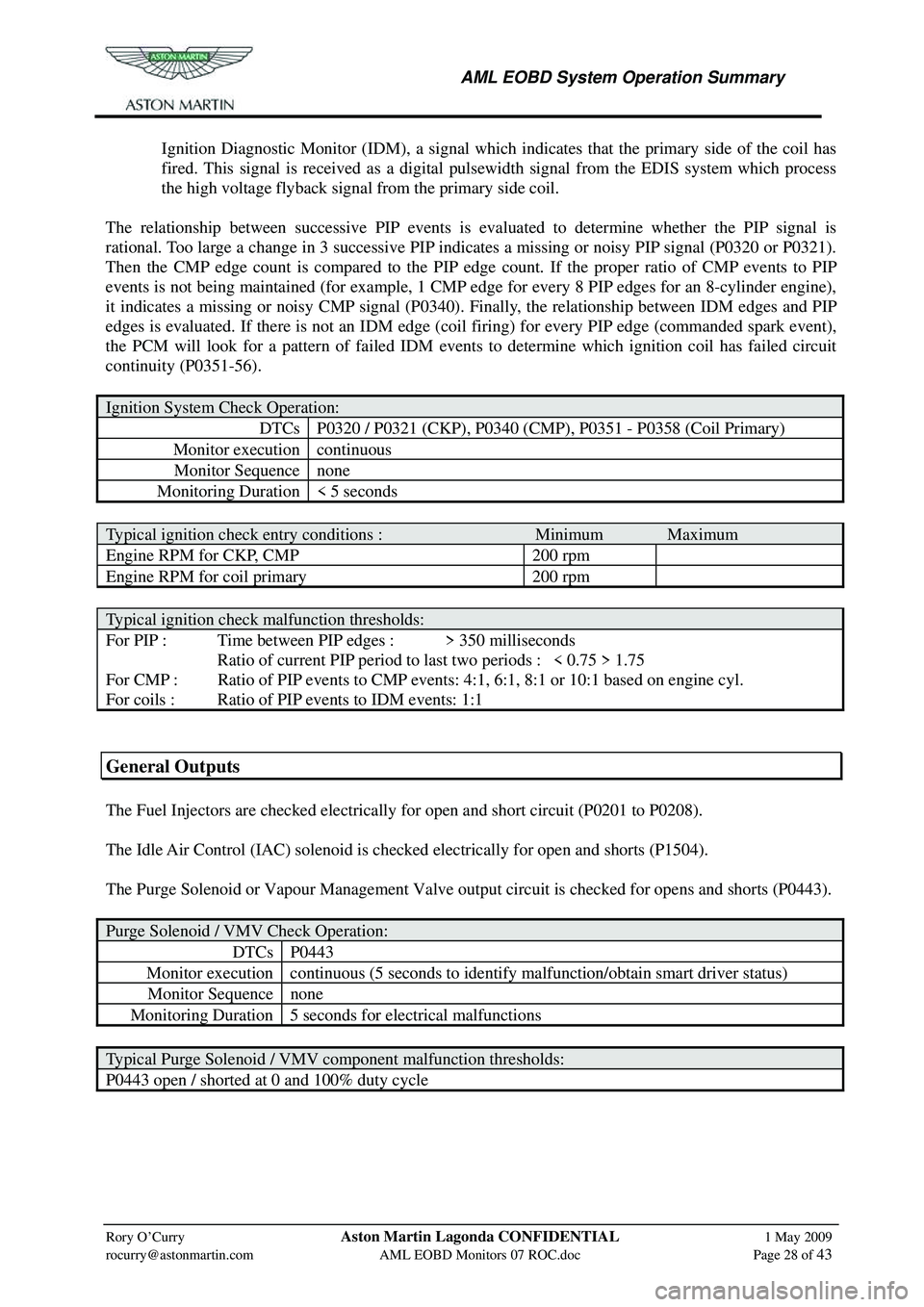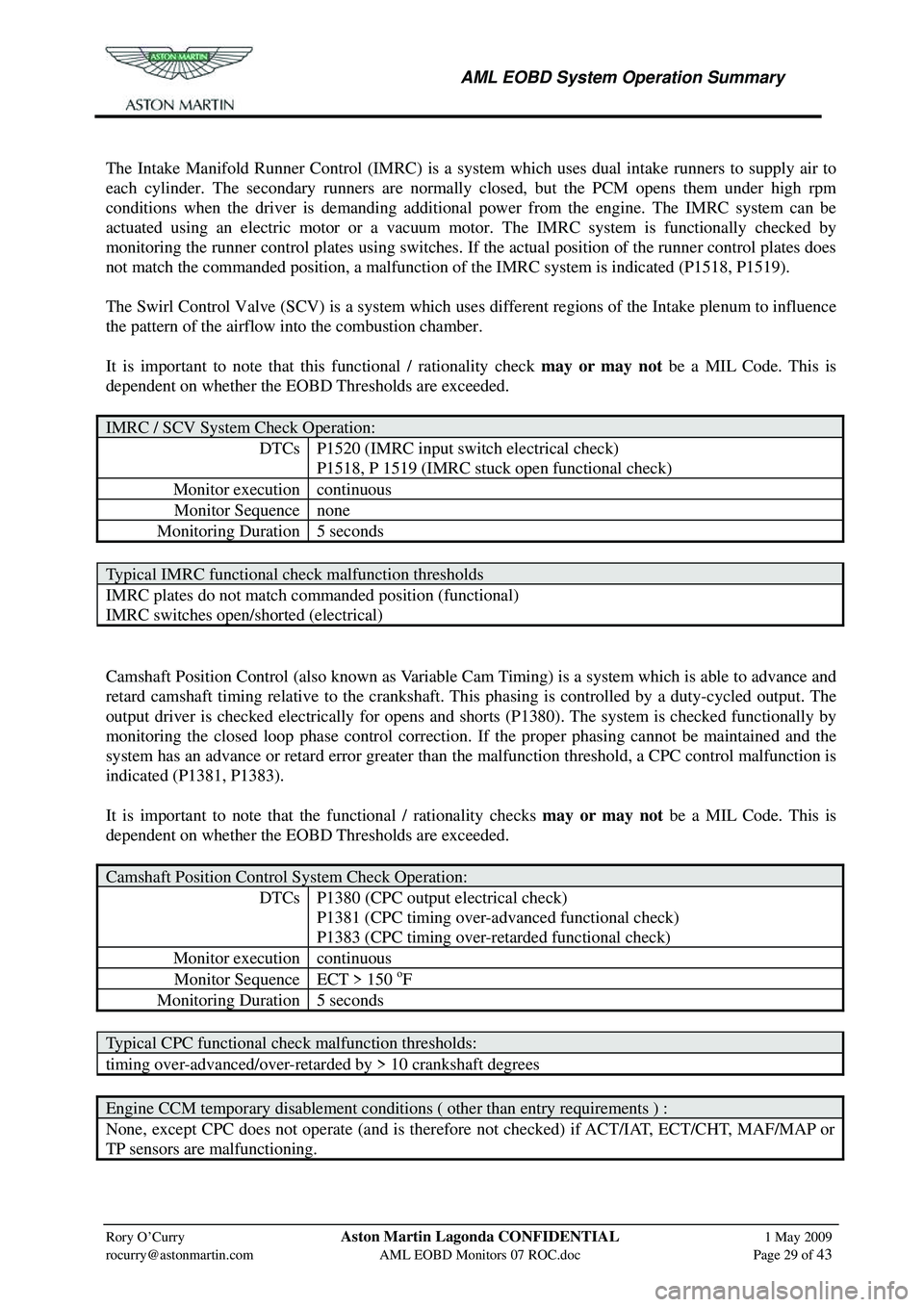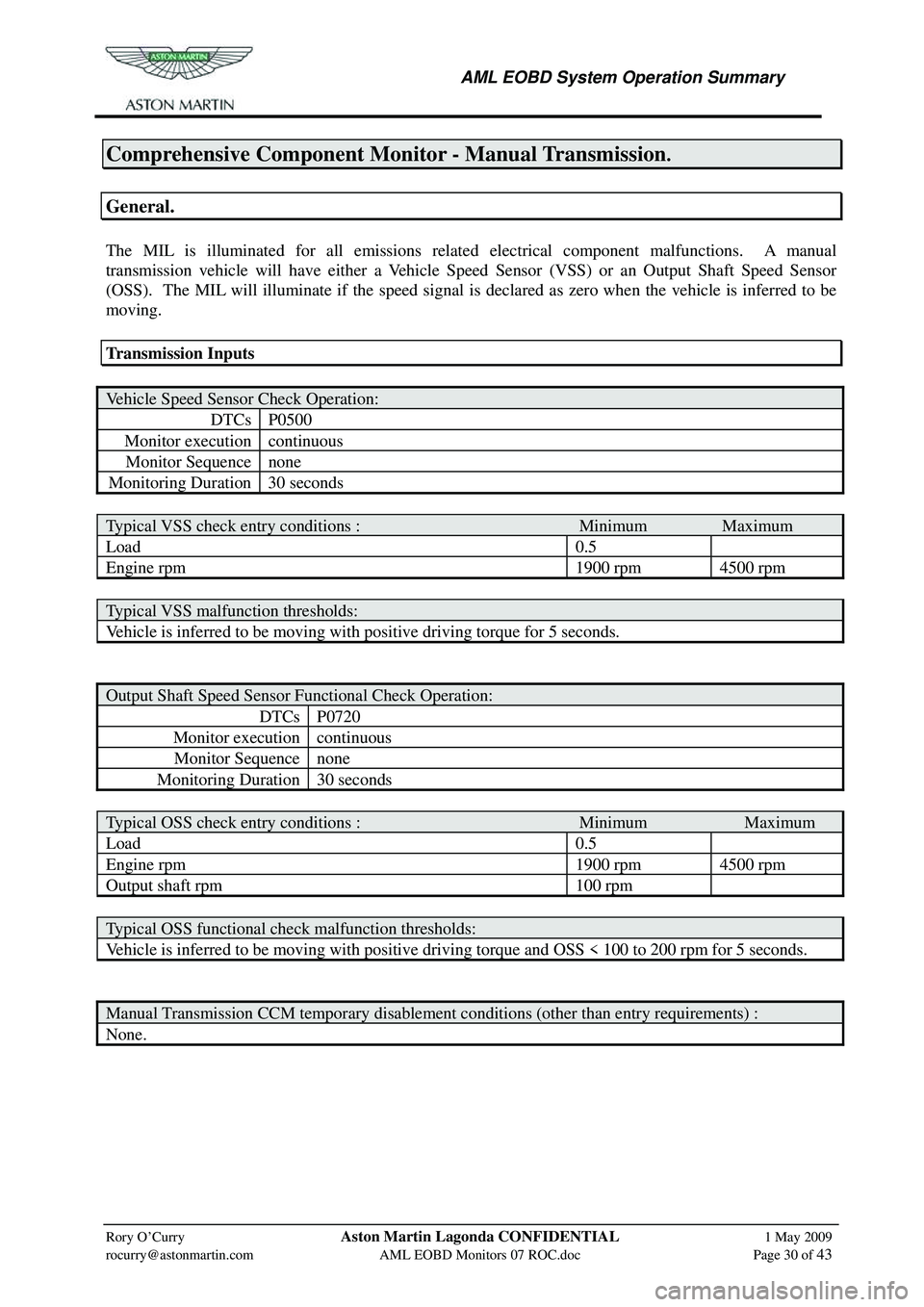2010 ASTON MARTIN V8 VANTAGE check engine
[x] Cancel search: check enginePage 860 of 947

AML EOBD System Operation Summary
Rory O’Curry Aston Martin Lagonda CONFIDENTIAL 1 May 2009
[email protected] AML EOBD Monitors 07 ROC.doc Page 14 of 43
After the vehicle is started, during vehicle acceleration, the differential pressure indicated by the DPFE
sensor at zero EGR flow is checked to ensure that both hoses to the DPFE sensor are connected. Under
this condition, the differential pressure should be zer o. If the differential pressure indicated by the DPFE
sensor exceeds a maximum threshold or falls below a minimum threshold, an upstream or downstream
DPFE hose malfunction is indicated (P1405 P1406).
EGR Hose Check Operation:
DTCs P1405, P1406
Monitor execution once per driving cycle
Monitor Sequence Done after P0402 test
Sensors OK MAF, MAP
Monitoring Duration 2 seconds to register a malfunction
Typical EGR hose check entry conditions : Minimum Maximum
EVR duty Cycle (EGR commanded off) 0% 0%
Mass Air Flow 8 lb/min
Inferred exhaust back pressure 13 in H2O
Typical EGR hose check malfunction thresholds:
DPFE sensor voltage: < -7 in H2O, > 7 in H2O
After the vehicle has warmed up and normal EGR rates are being commanded by the PCM, the low flow
check is performed. Since the EGR system is a closed loop system, the EGR system will deliver the
requested EGR flow as long as it has the capacity to do so. If the EVR duty cycle is very high (greater
than 80% duty cycle), the differential pressure indicated by the DPFE sensor is evaluated to determine the
amount of EGR system restriction. If the differential pr essure is below a calibratable threshold, a low flow
malfunction in indicated (P0401).
EGR Flow Check Operation:
DTCs P0401
Monitor execution once per driving cycle
Monitor Sequence Done after P1405 and P1406 tests
Sensors OK CPS, ECT, IAT, MAF, MAP, TP
Monitoring Duration minimum 70 seconds to register a malfunction
Typical EGR flow check entry conditions: Minimum Maximum
EVR Duty Cycle 80% 100%
Engine RPM 2500 rpm
Mass Air Flow Rate of Change 6% prog. loop
Inferred manifold vacuum 6 in Hg 10 in Hg
Typical EGR flow check malfunction thresholds:
DPFE sensor voltage: < 6 in H2O
EGR Monitor temporary disablement conditions ( other than entry requirements ) :
Non-operational when base feature disabled, including matching base feature temperature disablement.
Low Barometric Pressure Conditions.
Reporting of faults suppressed below 32° F to prevent mis-diagnosis due to ice. Monitor is still operational
and continues to check, reporting any faults when temperature > 32 °F.
Page 869 of 947

AML EOBD System Operation Summary
Rory O’Curry Aston Martin Lagonda CONFIDENTIAL 1 May 2009
[email protected] AML EOBD Monitors 07 ROC.doc Page 23 of 43
SAIR System Monitor – Flow Check
When the air pump is energized, the MAF sensor will show a corresponding increase in airflow. The
SAIR pump flow check monitors the MAF sensor signal and two air flow models during normal
secondary air system operation to determine if secondary air is being delivered into the exhaust system.
The SAIR pump flow test compares the actual change in MAF during the pump on and off transitions to
the expected change in airflow from the secondary air fl ow model. (A throttle body flow model is used to
"zero out" errors in the air meter and to compensate fo r transient driving conditions.) The actual airflow is
divided by the expected airflow to calculate an "On flow ratio" and an "Off flow ratio".
A flow ratio that is much less than 1.0 means that the air pump has no/low flow, or the inlet hose to the
pump is disconnected. If secondary air system operation ex tends into closed loop fuel, fuel trim feedback
is used to discriminate between low pump flow and in let hose disconnection. A low flow ratio with a lean
fuel system indicates a disconnected inlet hose. A flow ratio significantly higher than 1.0 (and/or a rich
fuel system indication) indicates that th e outlet hose from the pump is disconnected.
SAIR Diagnostic
The V8 uses the standard FORD non-intrusive monitor that has been adapted for use on a V-engine. The
detection capability is detailed below with the V8 specific modifications highlighted
P0410 - Pump inlet hose disconnection.
P0491 - Low airflow into the exhaust on Bank1. Blocked hose OR failed to open vacuum valve.
P0492 - Low airflow into the exhaust on Bank 2. Blocked hose OR failed to open vacuum
valve.
P2448 - Low airflow into the exhaust on Bank1. Disconnected outlet hose.
P2449 - Low airflow into the exhaust on Bank 2. Disconnected outlet hose.
P0412 - SAIR electrical circuit fault high/low on ecu control pin.
P2257 - SAIR electrical circuit fault high on monitor pin.
P2258 - SAIR electrical circuit fault low on monitor pin.
The determination of which bank is receiving low ai rflow is performed by monitoring the closed loop
fuelling correction supplied from the oxygen sensors. The bank that has the highest enleaning correction is
the bank that has the lowest SAIR flow. If closed loop fuelling is not active when the SAIR pump is
disabled the diagnostic cannot determ ine which bank is receiving low flow and so a fault on both banks is
raised.
The relative difference between the commanded lambda values for each bank is used to determine a
restricted flow to either bank1 or 2 due to a restricted outlet. This enables P0491, P0492 to be raised if the
flow ratio is calculated as in range.
The SAIR functional tests run when SAIR is active and the results are stored until the HEGO monitor has
completed (150-200 seconds after SAIR is off on a typical FTP74). It is only when the HEGO monitor has
completed successfully that any functional SAIR fa ults and SAIR monitor complete is reported.
Page 870 of 947

AML EOBD System Operation Summary
Rory O’Curry Aston Martin Lagonda CONFIDENTIAL 1 May 2009
[email protected] AML EOBD Monitors 07 ROC.doc Page 24 of 43
SAIR Diagnostic High Level Flow
AIR Monitor Flow Check Operation: onitor Flow Check Operation:
DTCs P0491 Pump Low Flow Bank1
P0492 Pump Low Flow Bank2
P0410 Pump Inlet Hose Off
P2448 Pump Outlet Hose Off Bank1
P2449 Pump Outlet Hose Off Bank2
P0412 primary side circuit check
P2257, P2258 secondary side circuit checks
Monitor execution Flow check - once per driving cycle, circuit checks – continuous
Monitor Sequence Runs approx. 5 seconds after start during normal SAIR operation
Sensors OK ECT, IAT, MAF, TP, ETC, and HO2S
Monitoring Duration From 5 to 70 seconds
Typical AIR flow check entry conditions: (The monitor will run when the air pump
runs, the entry conditions below are secondary air system entry conditions.) re secondary air
system entry conditions.)
Entry condition Minimum Maximum
Time since engine start-up 5 seconds 70 seconds
Engine Coolant Temperature -7oC (20oF) 35oC (90oF)
Predicted Pump Flow 18.5kg/h (0.68lb/min)
Manifold Vacuum 13.2kPa (3.9”Hg)
Catalyst Temperature 847oC (1558oF)
Inlet Air Temperature -12oC (10oF)
Battery Voltage 11 volts 18 volts
Note: There is a Throttle position stability ch eck that can delay the calculation of the flow ratio. If the throttle is continuously moving, it is
possible, to delay calculation of the flow ratio.
Typical AIR functional check malfunction thresholds:heck malfunction thresholds:
On Flow ratio < 0.75 (P0491, P0492 - Low Flow or, P0410 - Inlet Hose Off)
Off Flow ratio < 0.75 (P0491, P0492 - Lo w Flow or, P0410 - Inlet Hose Off)
Fuel Shift >0.3/Long term fuel shift bank1/bank2 (Clears possible outlet blocked P0491/92, but leaves valid P0410)
Bank1 – Bank2 lambda correcti on error >0.5 (P0491, P0492)
Closed Loop Fuel Control Active >10 seconds (P0491, P0492 – Low Flow)
On Flow ratio > 1.58 (P2448, P2449 – Outlet Hose Off)
Page 871 of 947

AML EOBD System Operation Summary
Rory O’Curry Aston Martin Lagonda CONFIDENTIAL 1 May 2009
[email protected] AML EOBD Monitors 07 ROC.doc Page 25 of 43
VCT Monitor
Variable Cam Timing System Monitor
VCT Hardware
Variable Cam Timing (VCT) enables rotation of the camshaft(s) relative to the crankshaft (phase-shifting)
as a function of engine operating conditions. Intake Only (phase-shifting only the intake cam) is used in
the AML application.
VCT is used primarily to increase internal residua l dilution at part throttle to reduce NOx, and to
improve fuel economy. With Intake Only VCT, the in take camshaft is advanced at part throttle and WOT
(at low to mid-range engine speeds) to open the in take valve earlier for increased residual dilution and
close the intake valve earlier in the compression stroke for increased power. When the engine is cold,
opening the intake valve earlier warms the charge which improves fuel vaporization for less HC
emissions; when the engine is warm, the residua l burned gasses limit peak combustion temperature to
reduce NOx formation.
The VCT system hardware consists of a contro l solenoid and a pulse ring on the camshaft. The PCM
calculates relative cam position using the CMP input to process variable reluctance sensor pulses coming
from the pulse ring mounted on the camshaft. Each pul se wheel has N + 1 teeth where N = the number of
cylinders per bank. The N equally spaced teeth are used for cam phasing; the remaining tooth is used to
determine cylinder # 1 position. Relative cam position is calculated by measuring the time between the
rising edge of profile ignition pickup (PIP ) and the falling edges of the VCT pulses.
VCT Diagnostic
The PCM continually calculates a cam position error value based on the difference between the desired
and actual position and uses this information to cal culate a commanded duty cycle for the VCT solenoid
valve. When energized, engine oil is allowed to flow to the VCT unit thereby advancing and retarding cam
timing. The VCT logic calculates the instantaneous va riance in actual cam position (the squared difference
between actual cam position and commanded cam position), then calculates the long term variance using a
rolling average filter (Exponentially Weighted Moving Average).
If the VCT system is stuck or operates with an consta nt error relative to the target position, the monitor
will detect a variance which will quickly accumulate. There are three variance indices that monitor cam
variance in the retard direction, the advance directi on, and for V engines, the difference between banks. If
any variance index is greater than the malfunction threshold, a VCT target error malfunction will be
indicated (P0011, P0012 Bank 1, P0021, P0022 Bank 2).
The VCT solenoid output driver in the PCM is check ed electrically for open circuit and shorts (P0010
Bank 1, P0020 Bank 2).
VCT Monitor Operation:
Page 873 of 947

AML EOBD System Operation Summary
Rory O’Curry Aston Martin Lagonda CONFIDENTIAL 1 May 2009
[email protected] AML EOBD Monitors 07 ROC.doc Page 27 of 43
Comprehensive Component Monitor - Engine
General Inputs
Analog inputs such as Ambient Air Temperature (P0072, P0073), Intake Air Temperature (P0112, P0113),
Engine Coolant Temperature (P0117, P0118), Cylinder Head Temperature (P1289, P1290), Mass Air Flow
(P0102, P0103) and Manifold Absolute Pressure (P0107, P0108) are checked for opens, shorts, or out-of-
range values by monitoring the analog -to-digital (A/D) input voltage.
Analog Sensor Check Operation:
DTCs P0072, P0073, P0112, P0113, P0117, P0118, P0102, P0103, P0107, P0108,
P1289, P1290
Monitor execution continuous
Monitor Sequence none
Monitoring Duration 5 seconds to register a malfunction
Typical analog sensor check malfunction thresholds:
Voltage < 0.20 volts or voltage > 4.80 volts
On Vehicles fitted with Cylinder Head Temperature (CHT ) Sensors, 'Fail Safe Cooling' can be applied if
the cylinder head temperature is too high. The P1299 DTC will be set under these conditions.
Loss of Keep Alive Memory (KAM) power (a separate wire feeding the PCM) results in a P1633 DTC and
immediate MIL illumination.
Loss or corruption of the Vehicle Identification (VID) Block in the PCM results in a P1639 DTC and
immediate MIL illumination.
Ignition
Electronic Ignition systems (Electronic Distributorless Ignition System - EDIS or Coil on Plug - COP)
systems are used on all applications.
The EDIS system, located in the PCM, processes the 36 (or 40) tooth crankshaft position signal to
generate a low data rate PIP signal to control a 4 or 6 terminal 'double-ended' coil pack. The 'double ended'
coils fire a pair of spark plugs simultaneously - one is on its compression stroke, the other on its exhaust
stroke. The COP system also uses the EDIS system in the same way as described above, however each
sparkplug has it’s own coil which is fired only once on the compression stroke.
The ignition system is checked by monitoring three ignition signals during normal vehicle operation:
Profile Ignition Pickup (CKP, commonly known as PIP), the timing reference signal derived from the crankshaft 36-tooth wheel and processed by the EDIS system. PIP is a 50% duty cycle, square
wave signal that has a rising edge at 10 ° BTDC.
Camshaft IDentification (CMP, commonly known at CID), a signal derived from the camshaft to identify the #1 cylinder
Page 874 of 947

AML EOBD System Operation Summary
Rory O’Curry Aston Martin Lagonda CONFIDENTIAL 1 May 2009
[email protected] AML EOBD Monitors 07 ROC.doc Page 28 of 43
Ignition Diagnostic Monitor (IDM), a signal which indicates that the primary side of the coil has
fired. This signal is received as a digital pulsewidth signal from the EDIS system which process
the high voltage flyback signal from the primary side coil.
The relationship between successive PIP events is ev aluated to determine whether the PIP signal is
rational. Too large a change in 3 successive PIP indicates a missing or noisy PIP signal (P0320 or P0321).
Then the CMP edge count is compared to the PIP e dge count. If the proper ratio of CMP events to PIP
events is not being maintained (for example, 1 CMP e dge for every 8 PIP edges for an 8-cylinder engine),
it indicates a missing or noisy CMP signal (P0340). Finally, the relationship between IDM edges and PIP
edges is evaluated. If there is not an IDM edge (co il firing) for every PIP edge (commanded spark event),
the PCM will look for a pattern of failed IDM events to determine which ignition coil has failed circuit
continuity (P0351-56).
Ignition System Check Operation:
DTCs P0320 / P0321 (CKP), P0340 (CMP), P0351 - P0358 (Coil Primary)
Monitor execution continuous
Monitor Sequence none
Monitoring Duration < 5 seconds
Typical ignition check entry conditions : Minimum Maximum
Engine RPM for CKP, CMP 200 rpm
Engine RPM for coil primary 200 rpm
Typical ignition check malfunction thresholds:
For PIP : Time between PIP edges : > 350 milliseconds
Ratio of current PIP period to last two periods : < 0.75 > 1.75
For CMP : Ratio of PIP events to CMP events: 4:1, 6:1, 8:1 or 10:1 based on engine cyl.
For coils : Ratio of PIP events to IDM events: 1:1
General Outputs
The Fuel Injectors are checked electrically for open and short circuit (P0201 to P0208).
The Idle Air Control (IAC) solenoid is checked electrically for open and shorts (P1504).
The Purge Solenoid or Vapour Management Valve output circuit is checked for opens and shorts (P0443).
Purge Solenoid / VMV Check Operation:
DTCsP0443
Monitor execution continuous (5 seconds to identify malfunction/obtain smart driver status)
Monitor Sequencenone
Monitoring Duration 5 seconds for electrical malfunctions
Typical Purge Solenoid / VMV component malfunction thresholds:
P0443 open / shorted at 0 and 100% duty cycle
Page 875 of 947

AML EOBD System Operation Summary
Rory O’Curry Aston Martin Lagonda CONFIDENTIAL 1 May 2009
[email protected] AML EOBD Monitors 07 ROC.doc Page 29 of 43
The Intake Manifold Runner Control (IMRC) is a syst em which uses dual intake runners to supply air to
each cylinder. The secondary runners are normally closed, but the PCM opens them under high rpm
conditions when the driver is demanding additiona l power from the engine. The IMRC system can be
actuated using an electric motor or a vacuum moto r. The IMRC system is functionally checked by
monitoring the runner control plates using switches. If the actual position of the runner control plates does
not match the commanded position, a malfunction of the IMRC system is indicated (P1518, P1519).
The Swirl Control Valve (SCV) is a system which uses di fferent regions of the Intake plenum to influence
the pattern of the airflow into the combustion chamber.
It is important to note that this functional / rationality check may or may not be a MIL Code. This is
dependent on whether the EOBD Thresholds are exceeded.
IMRC / SCV System Check Operation:
DTCs P1520 (IMRC input switch electrical check)
P1518, P 1519 (IMRC stuck open functional check)
Monitor execution continuous
Monitor Sequence none
Monitoring Duration 5 seconds
Typical IMRC functional check malfunction thresholds
IMRC plates do not match commanded position (functional)
IMRC switches open/shorted (electrical)
Camshaft Position Control (also known as Variable Cam Ti ming) is a system which is able to advance and
retard camshaft timing relative to the crankshaft. Th is phasing is controlled by a duty-cycled output. The
output driver is checked electrically for opens and s horts (P1380). The system is checked functionally by
monitoring the closed loop phase control correction. If the proper phasing cannot be maintained and the
system has an advance or retard error greater than the malfunction threshold, a CPC control malfunction is
indicated (P1381, P1383).
It is important to note that the functional / rationality checks may or may not be a MIL Code. This is
dependent on whether the EOBD Thresholds are exceeded.
Camshaft Position Control System Check Operation:
DTCs P1380 (CPC output electrical check)
P1381 (CPC timing over-advanced functional check)
P1383 (CPC timing over-retarded functional check)
Monitor execution continuous
Monitor Sequence ECT > 150 oF
Monitoring Duration 5 seconds
Typical CPC functional check malfunction thresholds:
timing over-advanced/over-retard ed by > 10 crankshaft degrees
Engine CCM temporary disablement conditions ( other than entry requirements ) :
None, except CPC does not operate (and is therefore not checked) if ACT/IAT, ECT/CHT, MAF/MAP or
TP sensors are malfunctioning.
Page 876 of 947

AML EOBD System Operation Summary
Rory O’Curry Aston Martin Lagonda CONFIDENTIAL 1 May 2009
[email protected] AML EOBD Monitors 07 ROC.doc Page 30 of 43
Comprehensive Component Monitor - Manual Transmission.
General.
The MIL is illuminated for all emissions relate d electrical component malfunctions. A manual
transmission vehicle will have either a Vehicle Speed Sensor (VSS) or an Output Shaft Speed Sensor
(OSS). The MIL will illuminate if the speed signal is declared as zero when the vehicle is inferred to be
moving.
Transmission Inputs
Vehicle Speed Sensor Check Operation:
DTCs P0500
Monitor execution continuous
Monitor Sequence none
Monitoring Duration 30 seconds
Typical VSS check entry conditions : Minimum Maximum
Load 0.5
Engine rpm 1900 rpm 4500 rpm
Typical VSS malfunction thresholds:
Vehicle is inferred to be moving with positive driving torque for 5 seconds.
Output Shaft Speed Sensor Functional Check Operation:
DTCs P0720
Monitor execution continuous
Monitor Sequence none
Monitoring Duration 30 seconds
Typical OSS check entry conditions : Minimum Maximum
Load 0.5
Engine rpm 1900 rpm 4500 rpm
Output shaft rpm 100 rpm
Typical OSS functional check malfunction thresholds:
Vehicle is inferred to be moving with positive driving torque and OSS < 100 to 200 rpm for 5 seconds.
Manual Transmission CCM temporary disablement conditions (other than entry requirements) :
None.